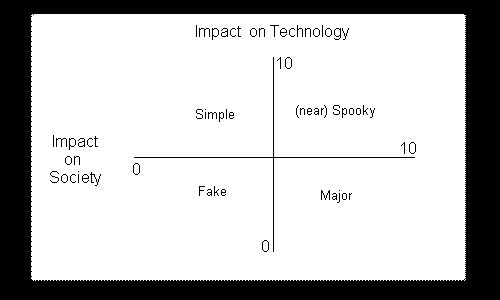Over a year ago Phil posted “Mapping The Development Space.” Phil’s post took four categories of possible nanotech developments (as conceived, I believe, by Glenn Reynolds) and put them on a grid:

These four categories are:
- Fake (where it’s basically a marketing term, as with nanopants);
- Simple: high-strength materials, sensors, coatings, etc — things that are important, but not sexy;
- Major: advanced devices short of true assemblers;
- Spooky: assemblers and related technology (true Molecular Nanotechnology).
At the time that post was written (waaay back in December of 2003) neither Glenn nor Phil believed any nanotech developments fell outside the “fake” quadrant.
We may have just entered a new quadrant.
Self-assembled nano-sized probes allow Penn researchers to see tumors through flesh and skin
PHILADELPHIA – Nano-sized particles embedded with bright, light-emitting molecules have enabled researchers to visualize a tumor more than one centimeter below the skin surface [in rats] using only infrared light…
“We have shown that the dispersion of thousands of brightly emissive multi-porphyrin fluorophores within the polymersome membrane can be used to optically image tissue structures deep below the skin – with the potential to go even deeper,” said Michael J. Therien, a professor of chemistry at Penn State. “It should also be possible to use an emissive polymersome vesicle to transport therapeutics directly to a tumor, enabling us to actually see if chemotherapy is really going to its intended target.”
…Polymersomes function much like the bilayered membranes of living cells. Whereas cell membranes are created from a double layer of fatty phospholipid chains, a polymersome is comprised of two layers of synthetic co-polymers. Like a living cell, the polymersome membrane has a hydrophobic core. The study shows that the fluorophores evenly disperse within this core, giving rise to a nanometer-sized light-emitting structure.
…Another feature that makes emissive polymersomes so useful is that they self-assemble. Simply mixing together all component parts gives rise to these functional nanometer-sized, cell-like vesicles.”
via KurzweilAI
This development involves self-assembled nano-sized structures that emit light. AND scientists “can use these [structures] to target markers on the surface of a specific type of tumor cells” so that they can see the tumor. AND these researchers are hopeful that this same nano-structure will also be useful in delivering chemotherapy.
While there is room for debate over whether this qualifies as “simple” or “major” nanotech (it isn’t quite spooky), this development is much more than “fake” nanotech.